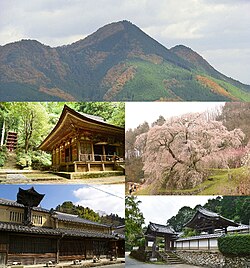Top Qs
Timeline
Chat
Perspective
Uda, Nara
City in Kansai, Japan From Wikipedia, the free encyclopedia
Remove ads
Uda (宇陀市, Uda-shi) is a city located in northeastern Nara Prefecture, Japan. As of 1 October 2024[update], the city had an estimated population of 26,814 in 12647 households, and a population density of 110 persons per km2.[1] The total area of the city is 247.50 km2 (95.56 sq mi).

Remove ads
Geography
Summarize
Perspective
Uda is located in northeastern Nara Prefecture. The terrain is flat land along the Uda River and Yoshino River, surrounded by mountains, and most of it is forested. The old urban areas of the former Utano Town area, the former Ouda Town area, and the former Haibara Town area are located on flat land, but the rest of the area is mountainous and has settlements scattered in narrow areas. The north side of the former Haibara Town area, the north and south sides of the former Muro Village area, and the south side of the former Utano Town area are connected to high mountainous areas.
Neighboring municipalities
Climate
Uda has a humid subtropical climate (Köppen climate classification Cfa), which is hot and humid in the summer (above 30 °C (86 °F)) and is somewhat cold in the winter with temperatures dropping to around freezing (0 °C (32 °F)). The average annual temperature in Uda is 12.3 °C. The average annual rainfall is 1893 mm with September as the wettest month. The temperatures are highest on average in August, at around 24.0 °C, and lowest in January, at around 0.7 °C.[2]
Demographics
Per Japanese census data, the population of Uda in 2020 is 28,121 people.[5] Uda has been conducting censuses since 1950.
Remove ads
History
The area of Uda was part of ancient Yamato Province. The name of "Uda" appears in ancient texts, including the Nara period Man'yōshū. During the Sengoku period and early Edo period, it was ruled from Uda Matsuyama Castle and was part of Uda-Matsuyama Domain until 1695, and part of the tenryō holdings of the Tokugawa shogunate to the Meiji restoration. Many historic buildings have been preserved in the old castle town. The town of Matsuyama was established with the creation of the modern municipalities system on April 1, 1889. It became the town of Ōuda on February 11, 1942. The city of Uda was established on January 1, 2006, the towns of Haibara, Ōuda and Utano, and the village of Murō (all from Uda District).[6][7]
Remove ads
Government
Uda has a mayor-council form of government with a directly elected mayor and a unicameral city council of 14 members. Uda, collectively with the villages in Uda district contributes one member to the Nara Prefectural Assembly. In terms of national politics, the city is part of the Nara 3rd district of the lower house of the Diet of Japan.
Economy
The economy of Uda is based on agriculture and forestry. However, due to its mountainous location, there is little farmland, with only small terraced paddy fields and fields developed in the 1970s as part of prefectural projects, and local vegetables are sold at a few direct sales outlets, mainly for self-consumption. Along with Yoshino, the area was traditionally noted for its production of Kudzu powder.
Remove ads
Education
Uda has six public elementary schools and four public junior high schools operated by the city government and one public high school operated by the Nara Prefectural Board of Education. There is also one private junior high school.
Transportation
Railways
Highways
Local attractions
- Murō-ji - A temple with the five-storied pagoda of Murō-ji
- Uda Matsuyama Castle - A castle ruin, one of the Continued Top 100 Japanese Castles[8]
- Uda Mikumari Shrine - A shrine, one of the National Treasures of Japan
- Ōno-dera, with National Historic Site magaibutsu
- Mita-Ōsawa Kofun Cluster, National Historic Site
- Morino physic garden, National Historic Site
References
External links
Wikiwand - on
Seamless Wikipedia browsing. On steroids.
Remove ads






